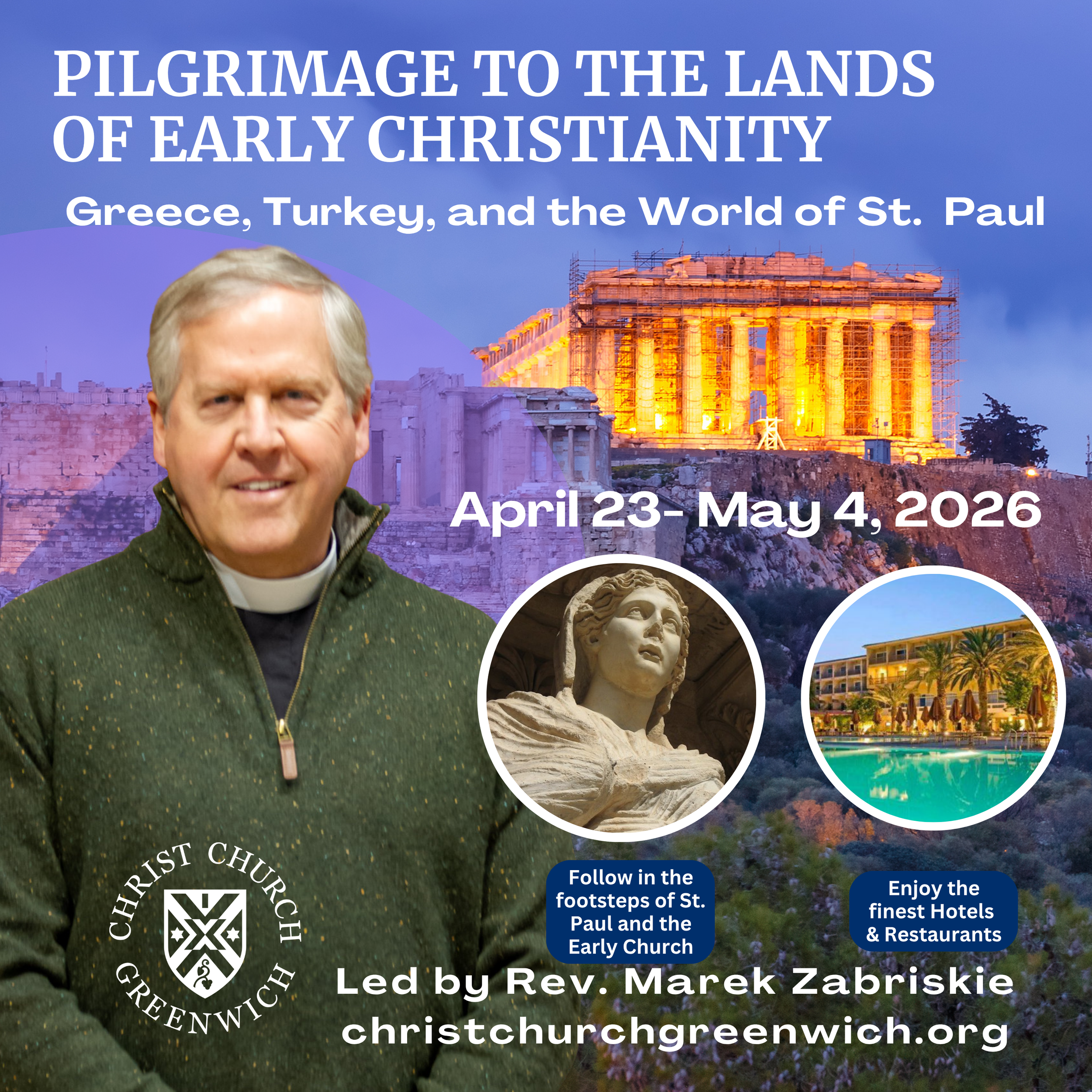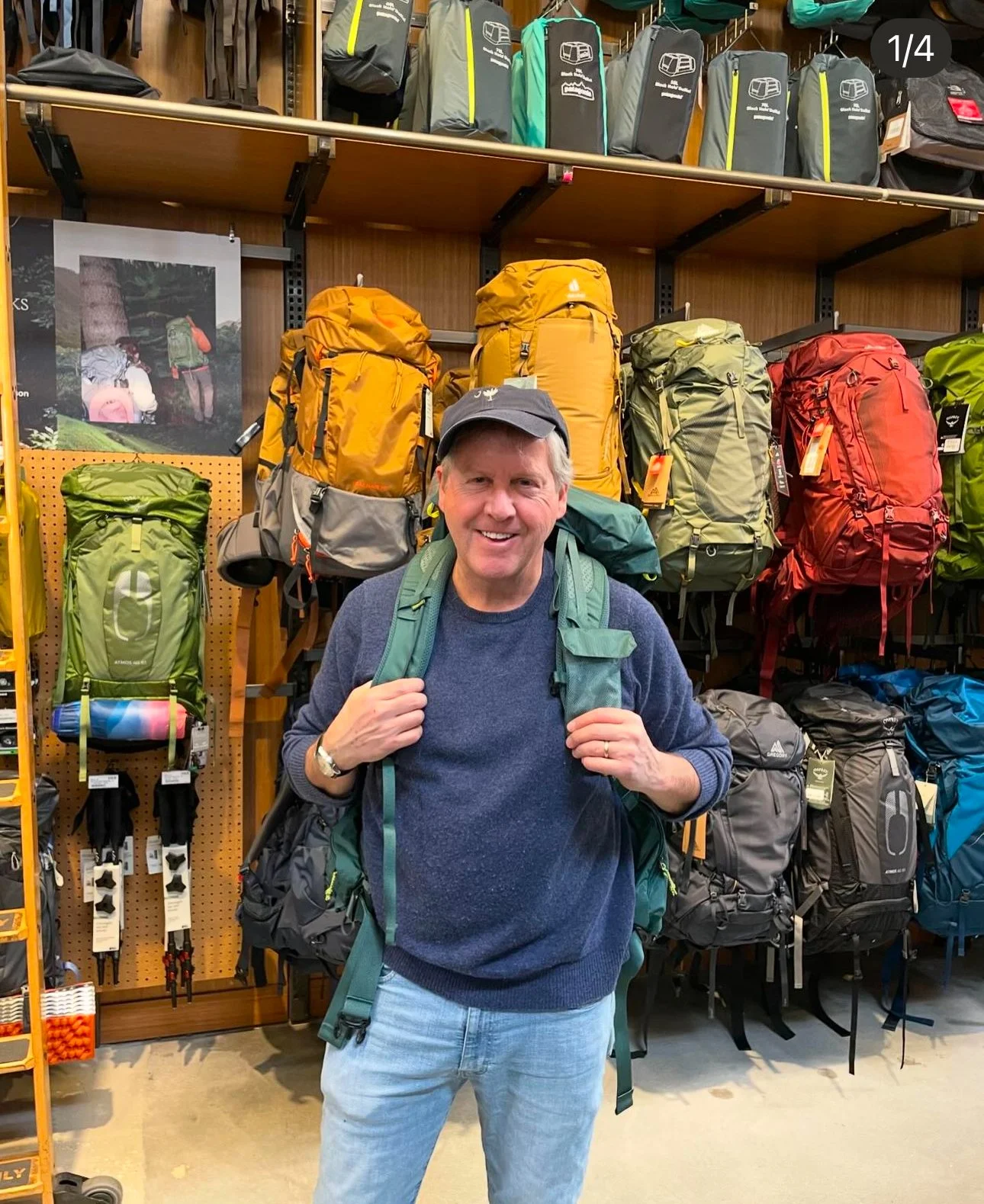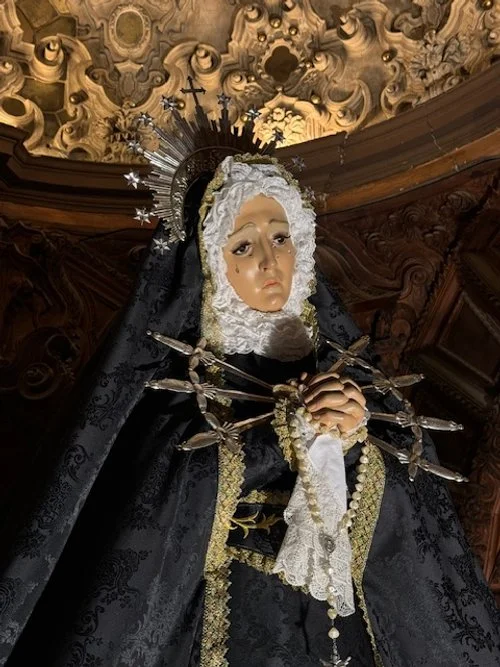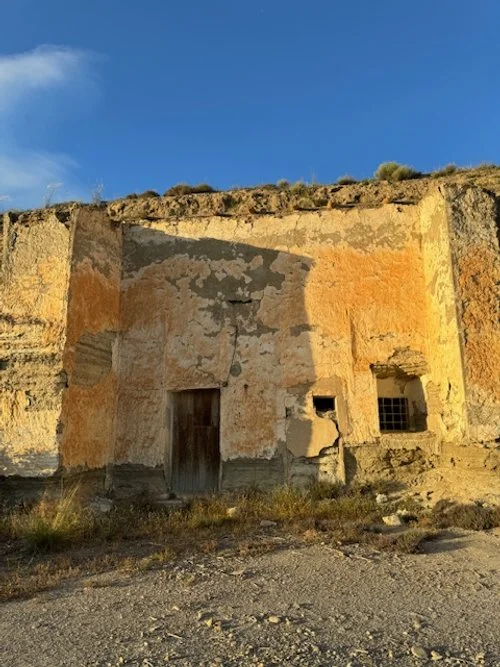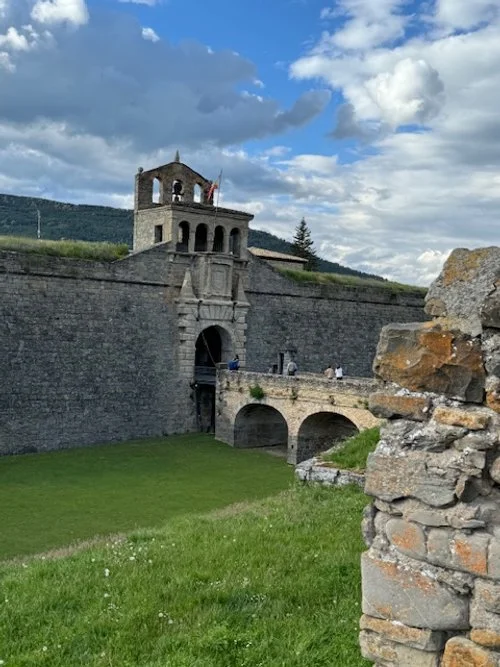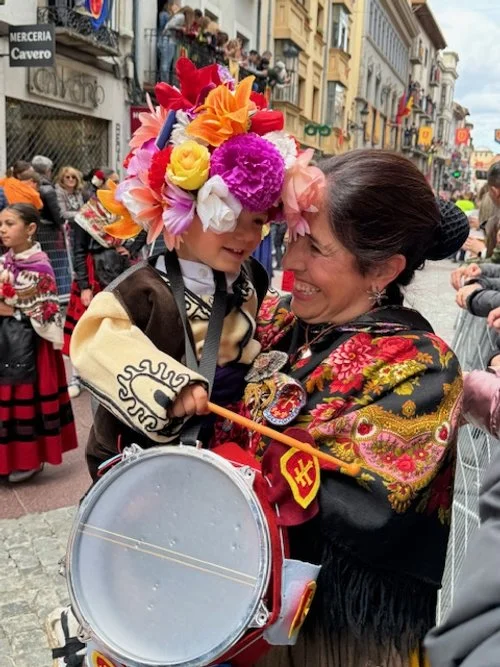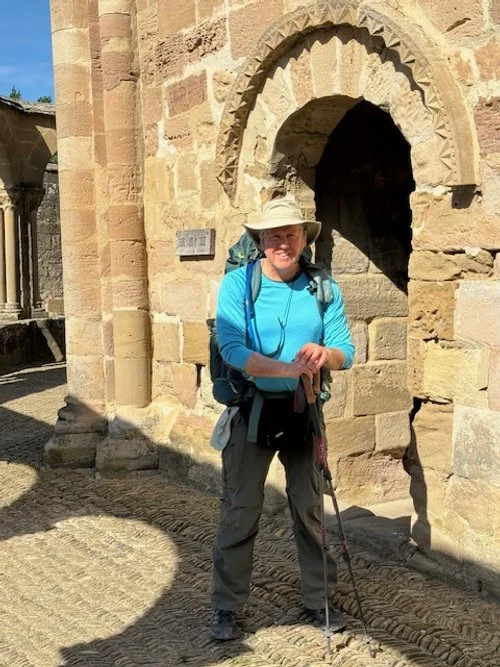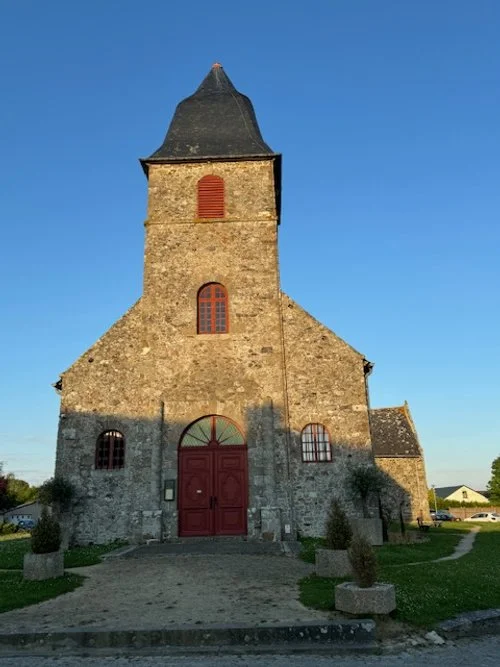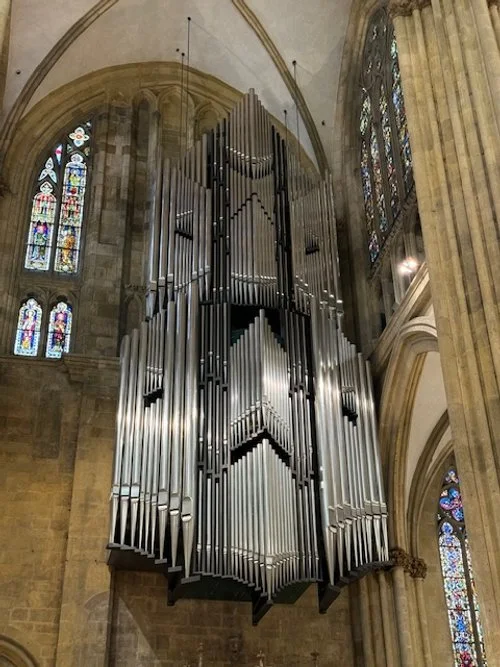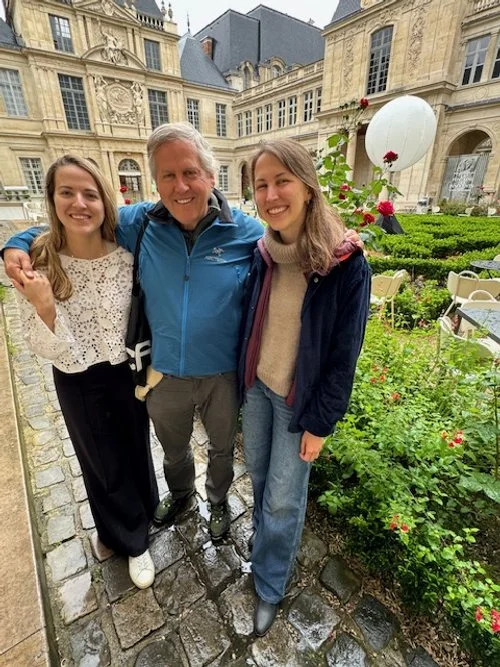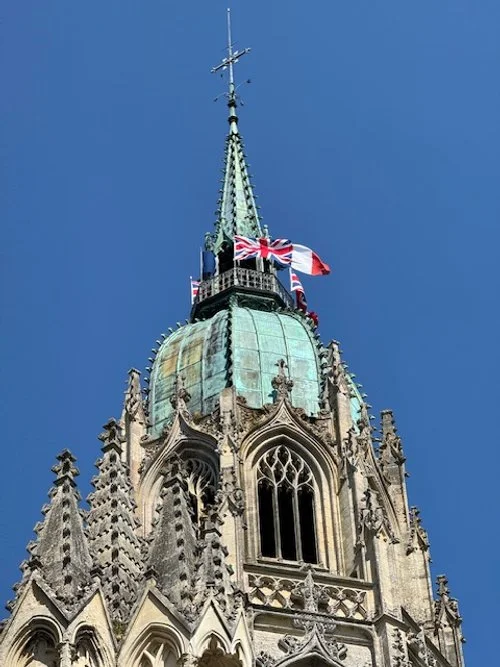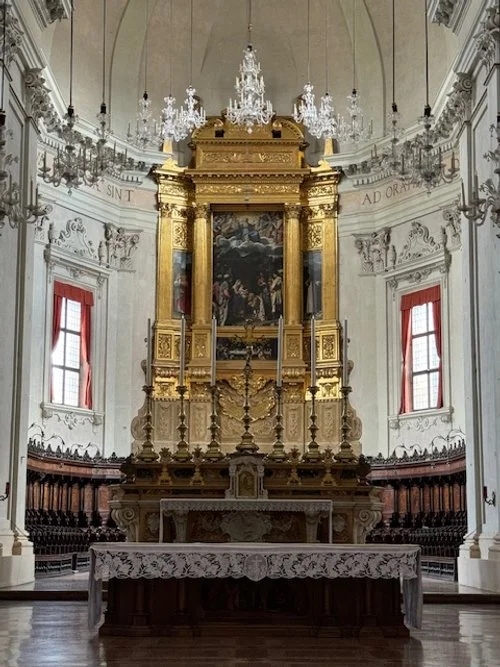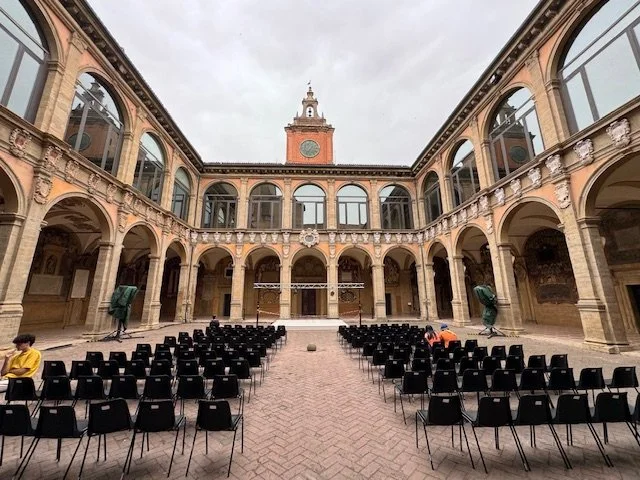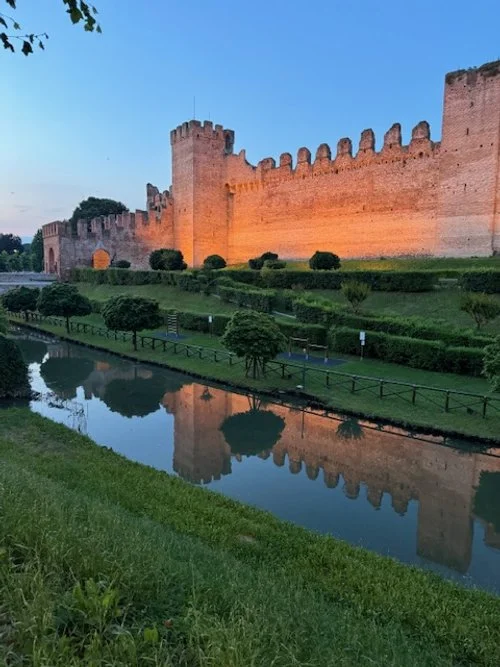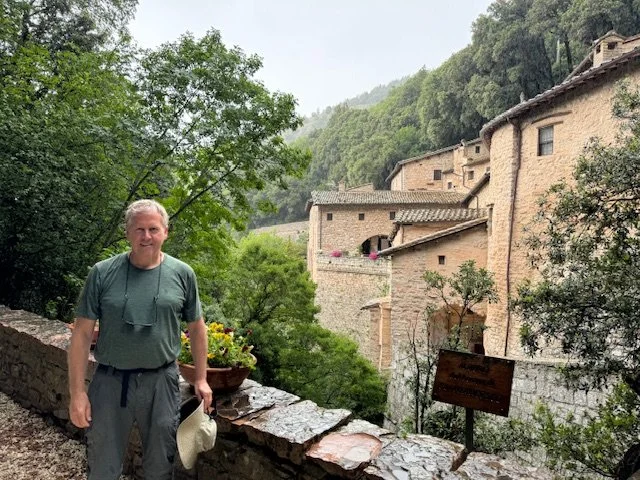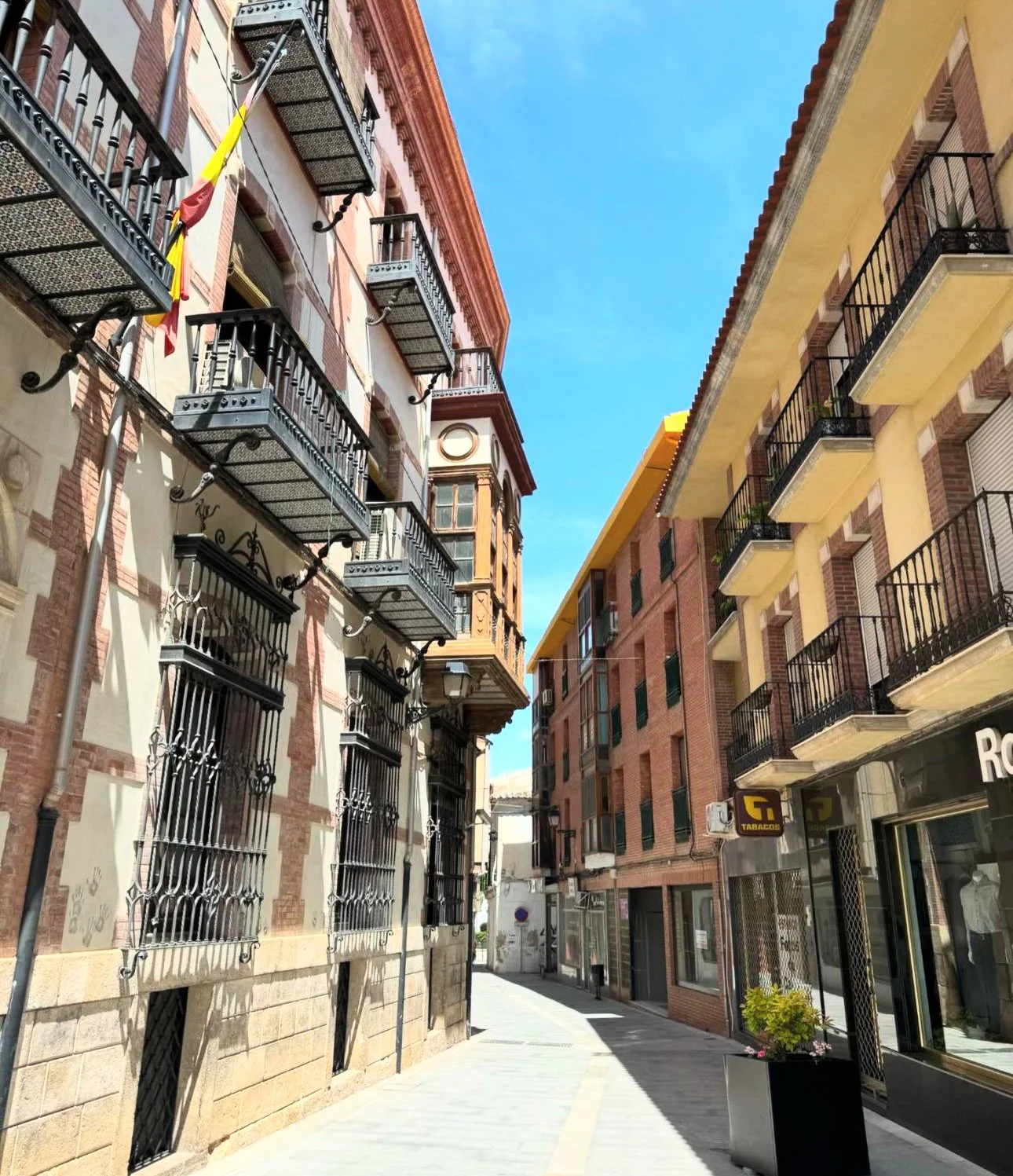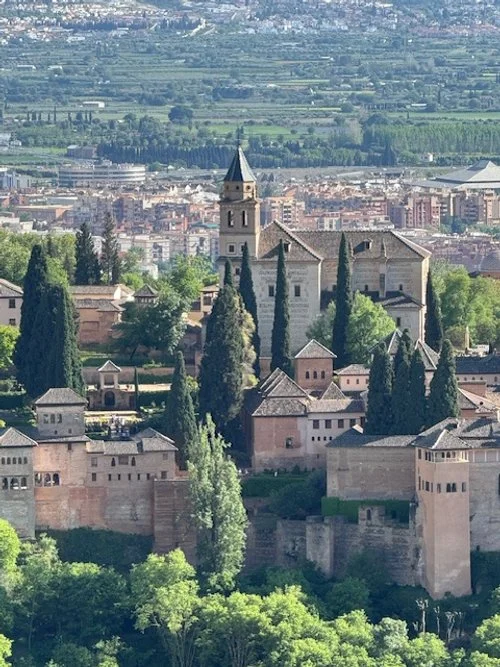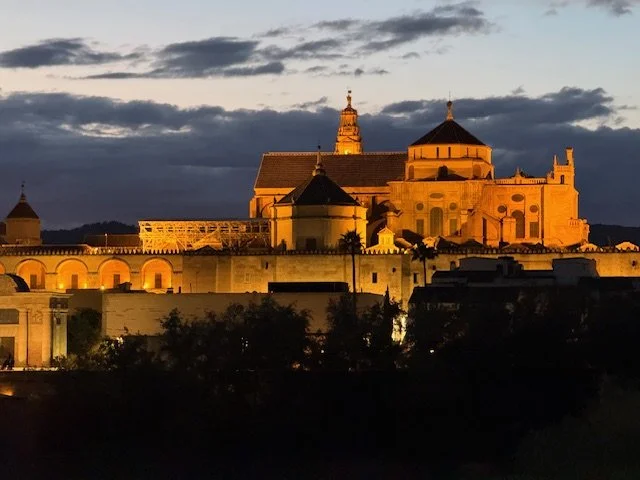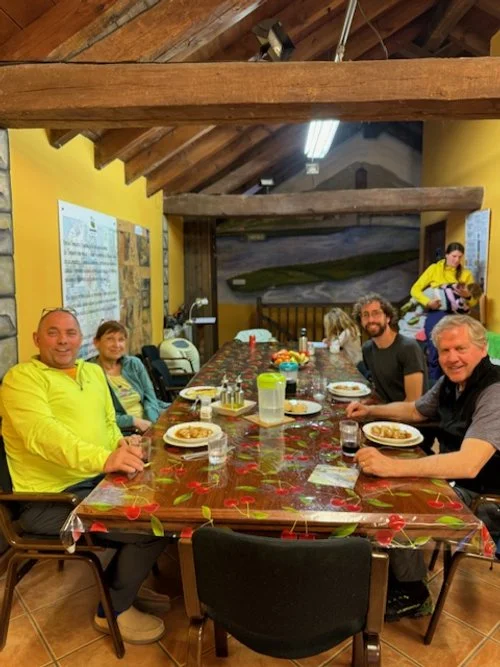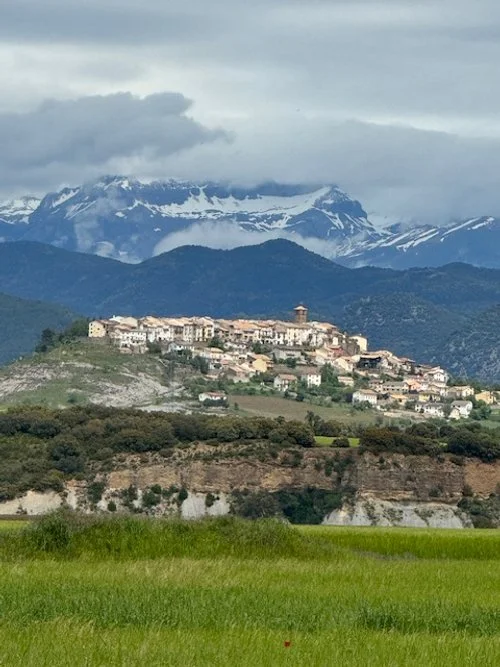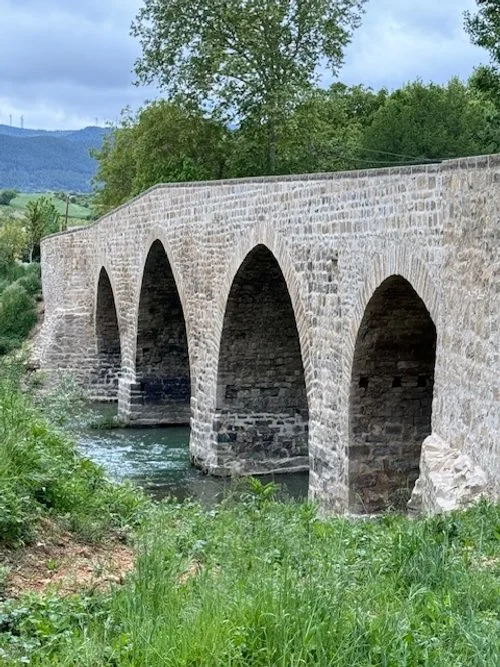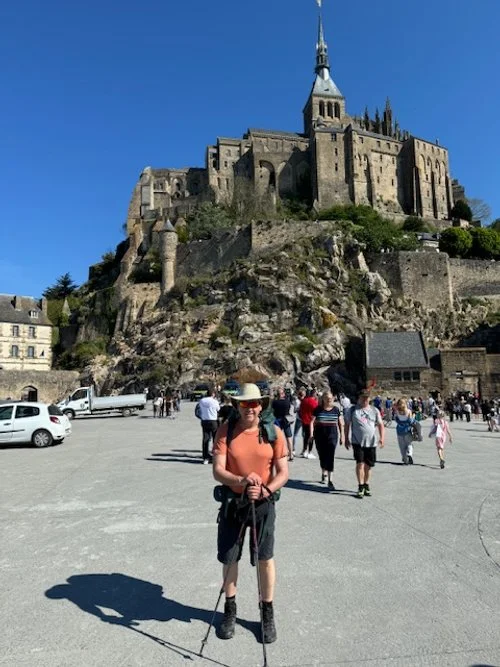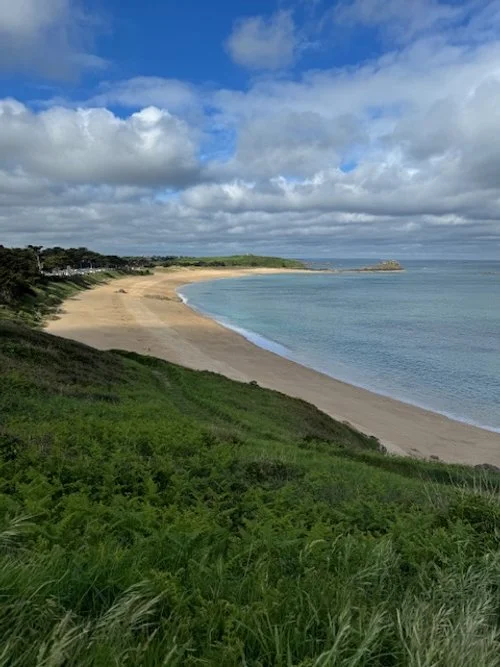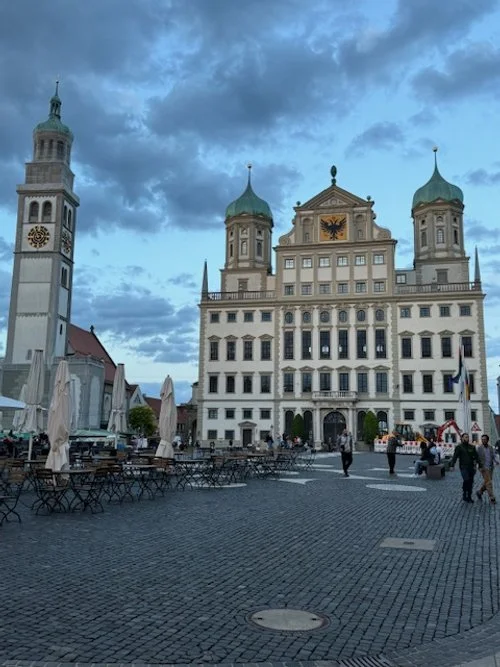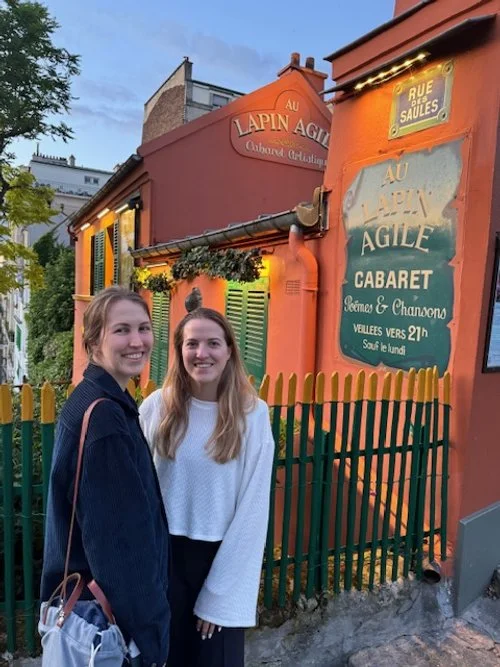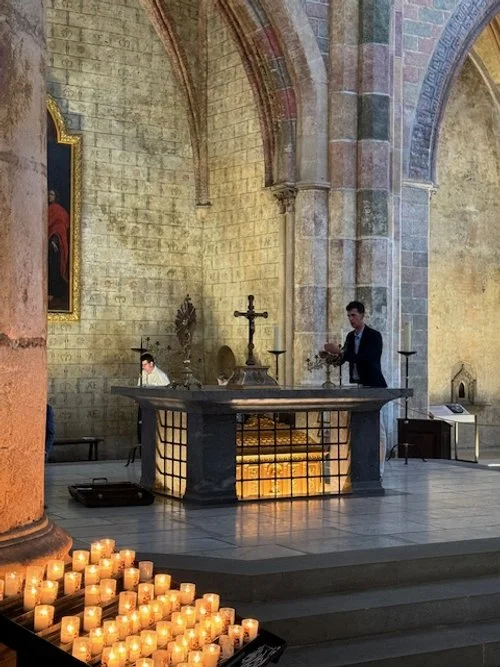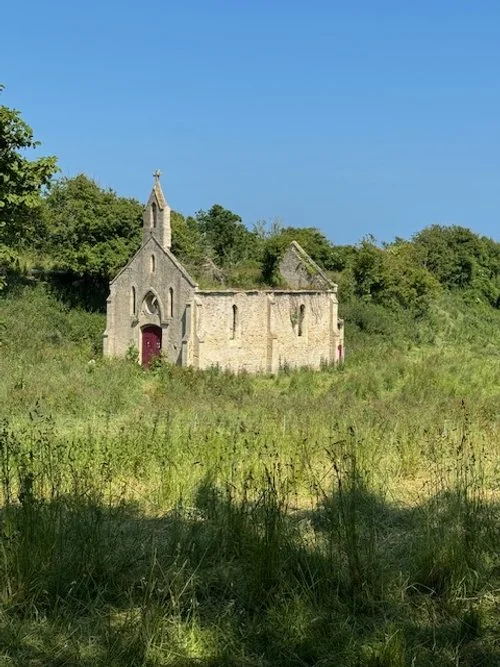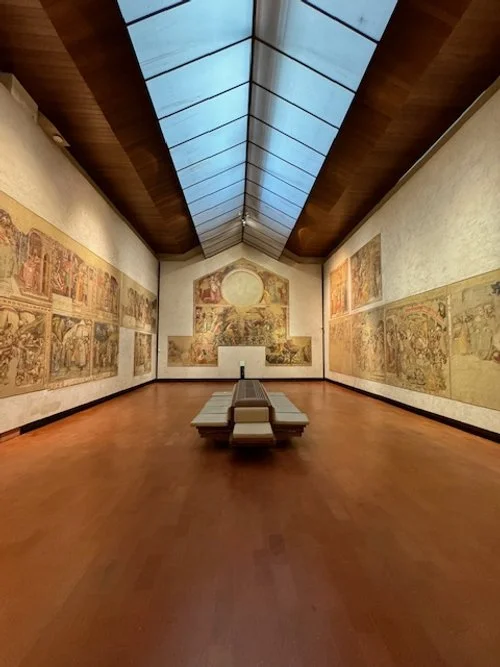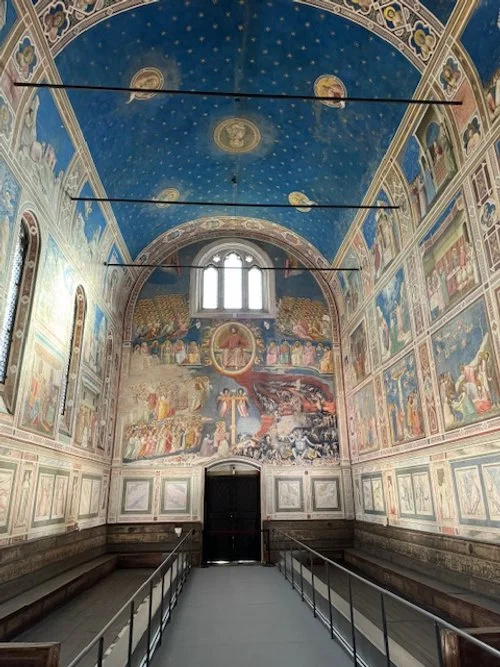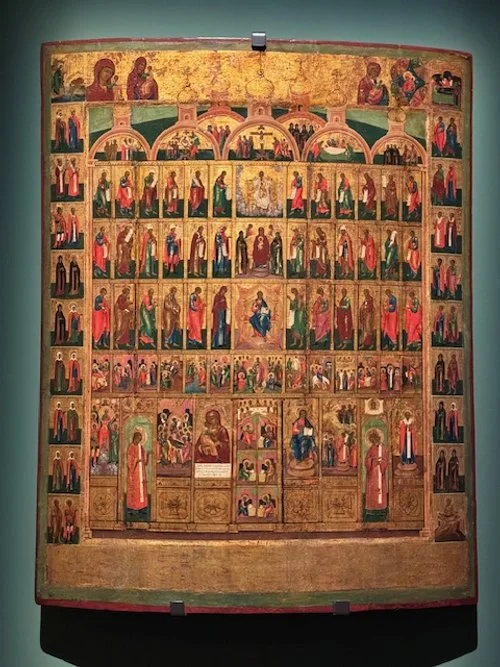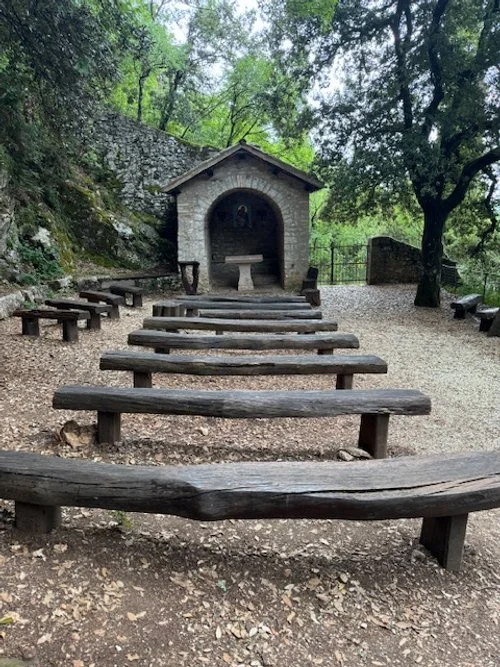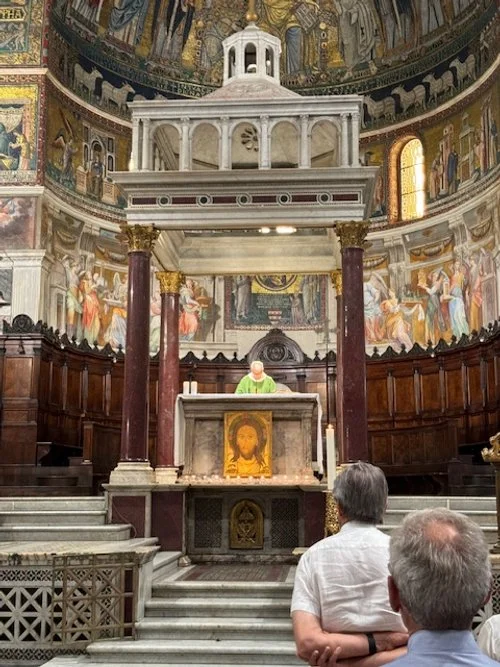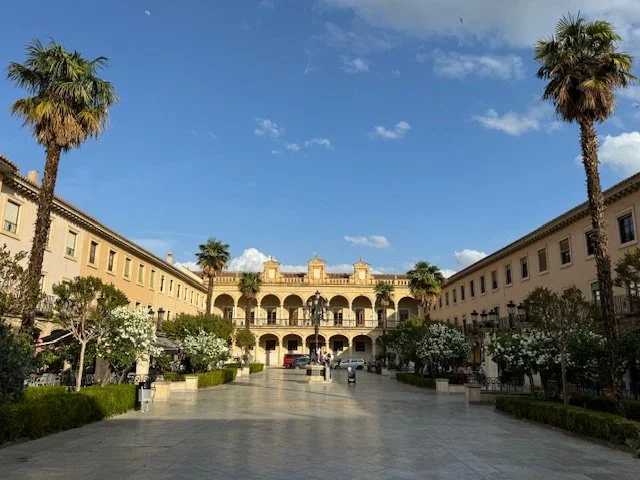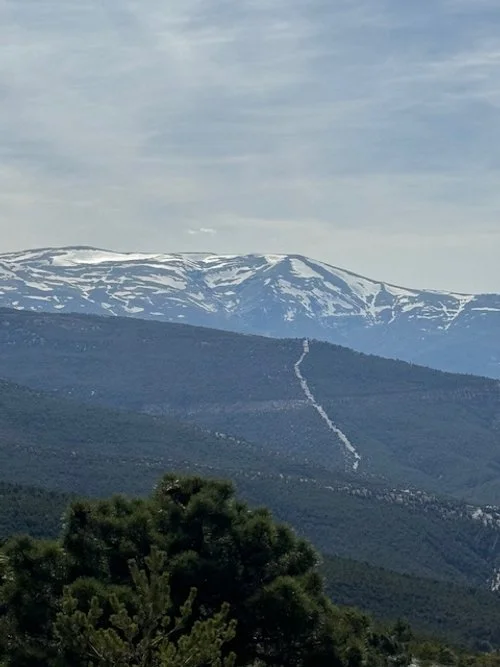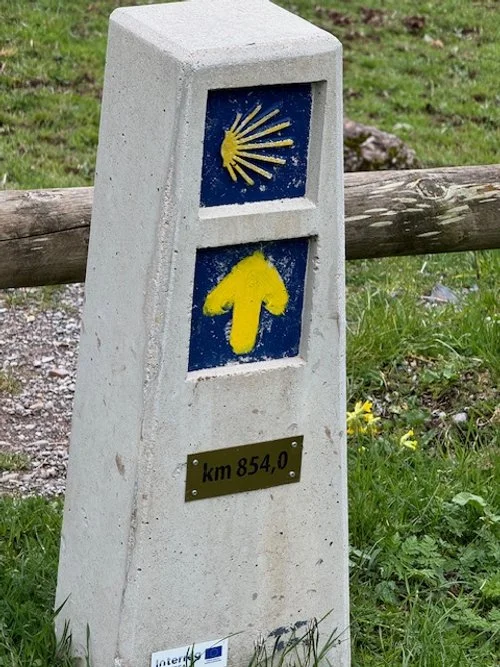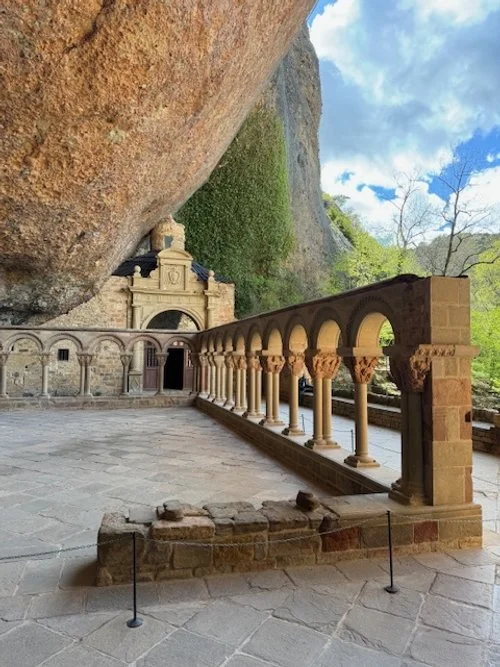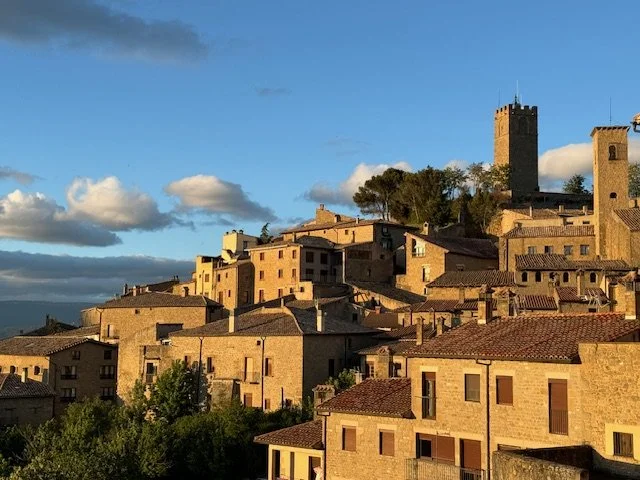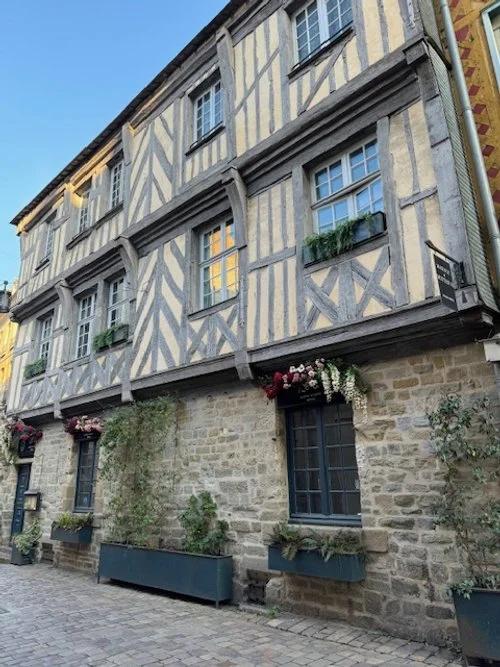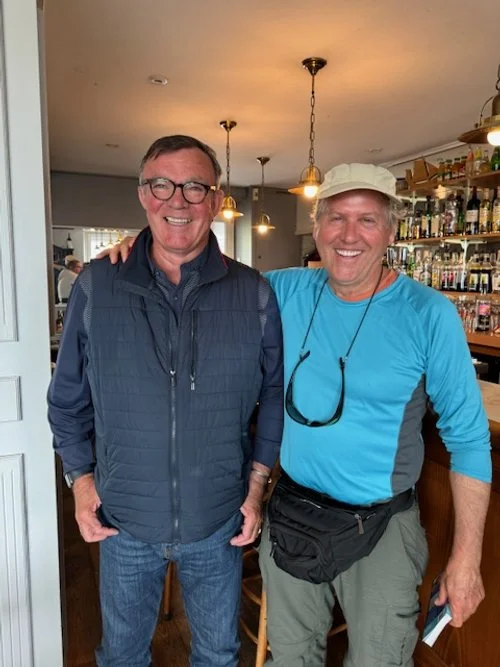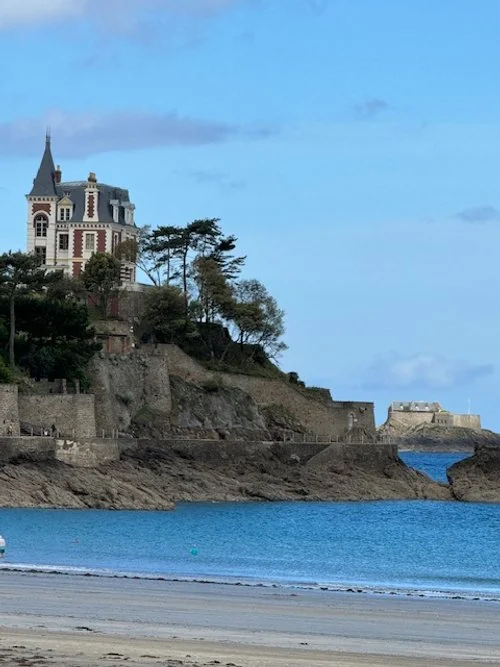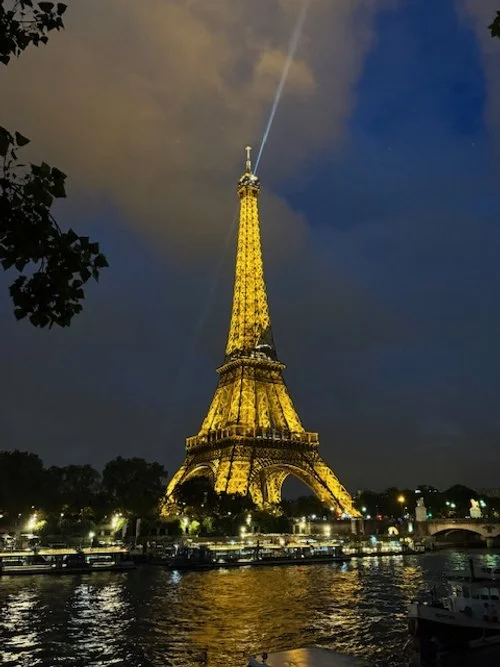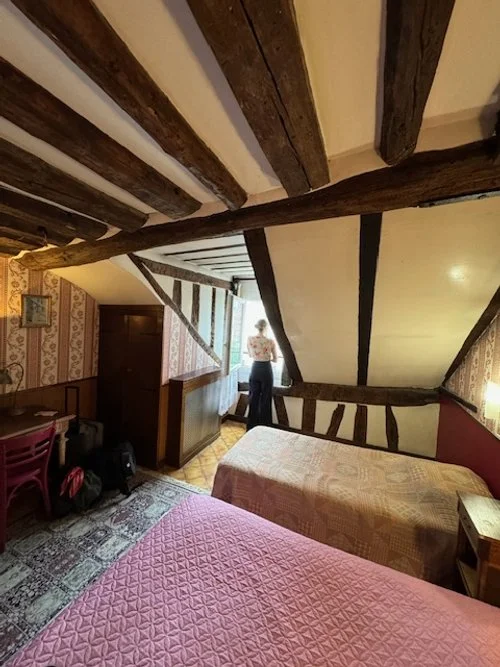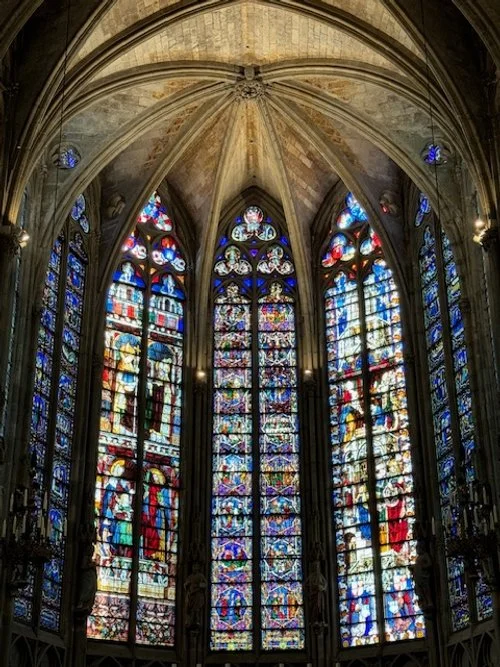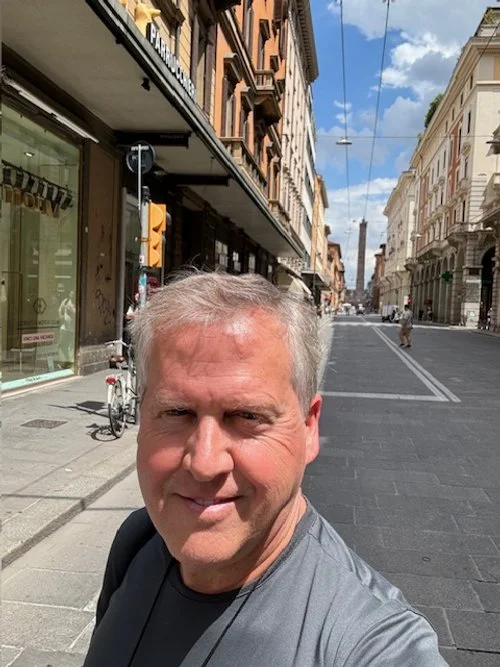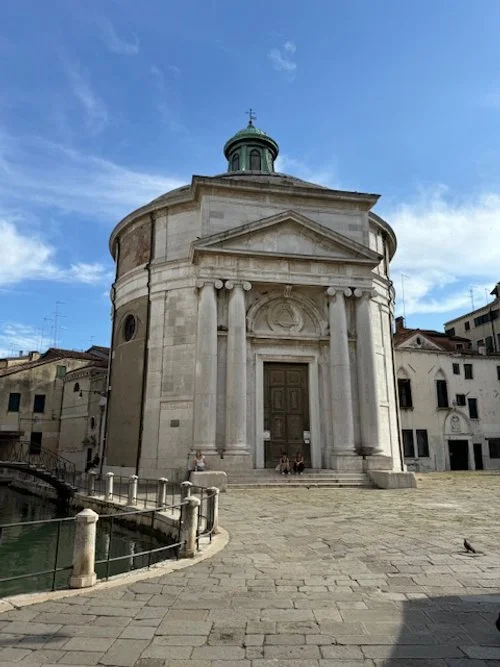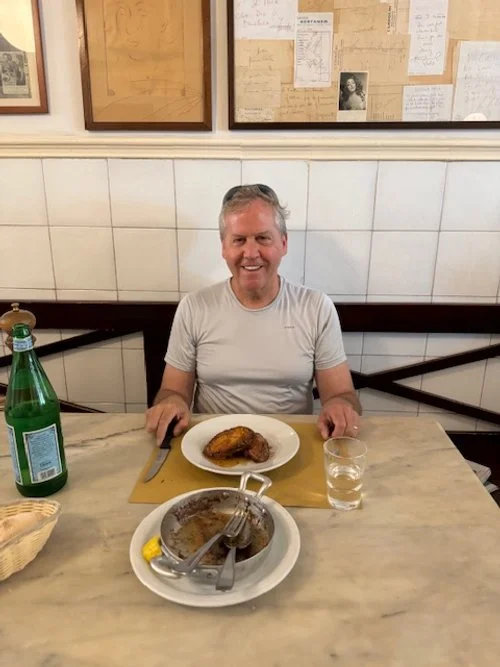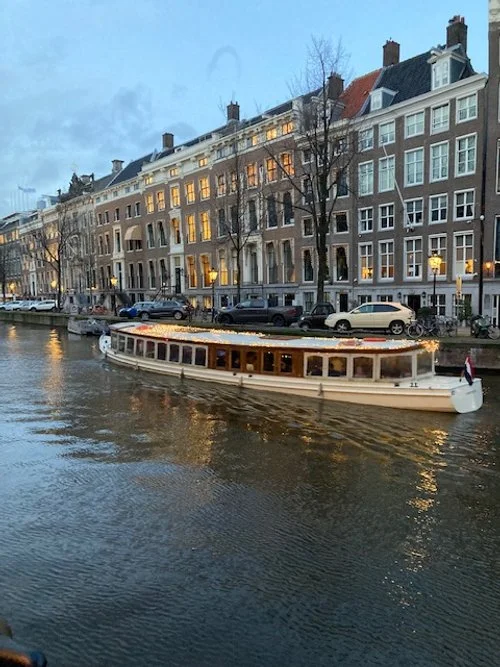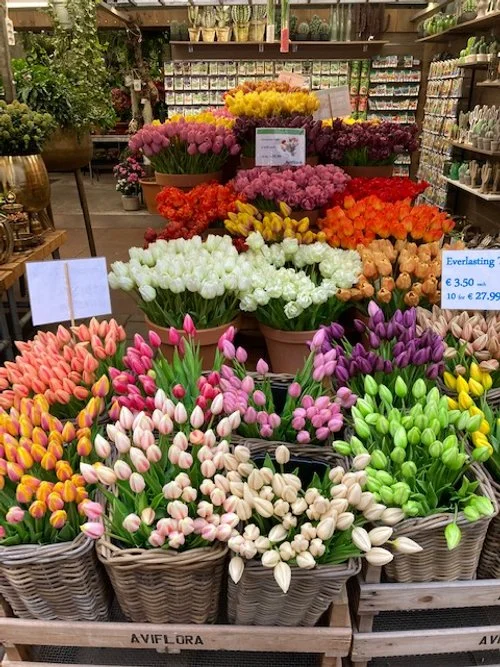Join Rev. Marek on an Sacred Adventure!
Greece, Turkey, & the World of St. Paul
April 23 - May 4, 2026
Spiritual Centers of Northern England
July 24 - August 1, 2026
Let’s Get Started…
Tuesday, April 16
Everything matters. Everything weighs something. Each ounce adds up. Any Camino like any journey begins with preparation - checking routes and destinations, buying new gear and equipment, taking stock of what’s still in good shape, and deciding what goes and what stays behind. My backpack will be my house for the next 90 days. Everything that I want and need must fit inside it. I weighed it at 22 pounds - not as good as I had hoped but better than I feared. I arrive tomorrow in Andalusia. Can’t wait to set my feet back on Spanish soil!
Granada
Sunday, April 21
After attending church and visiting the Chapel of Our Lady of Sorrows in Baza, we traveled to Granada, passing a horse drawn carriage on a main road. We explored the catacombs near Sacromonte in Granada today dating back to the first century, where San Cecilio - one of the two patrons saints of the city and a disciple of Santiago - St. James the Greater - was martyred in the first century. I love exploring sites like this that few Americans and tourists take time to see or even know about. Granada is one of my top ten favorite cities in Spain. It’s got a great vibe, incredible history, architecture, food, and so much to offer and do. Earlier in the day, I played my first doubles game of pádel, and we prevailed. It’s a great game and is incredibly easy to pick up. We ended the day by watching El Classico - the twice a year soccer match between El Real Madrid and Barcelona. I have probably spoken 40 hours of Spanish since arriving less than five days ago. This is the ideal way to learn a language.
Baza, Andalusia
Friday, April 26
Baza was an important city in this region of Andalusia long before Granada was established. Today, Granada has over 200,000 residents and another 150,000 in the surrounding region. Baza has only 21,000 residents, but an incredibly interesting heritage. It has been ruled by Phoenicians, Iberians, Visigoths, Romans, and Arabs, before being reconquered by Christians 500 years before the Christians reconquered Granada, which is only an hour away by car, in 1492. The history here is layered and rich. A highlight yesterday was visiting the casa/cuevas (cave houses) carved into the hillsides outside of Baza. At one very large cave, we had a drink in a casa rural that has a bar, restaurant, and seven rooms for rent, one of which has room for eleven guests to sleep. I met Antonio David, one of the local priests, and had a nice conversation in the plaza mayor of Baza.
Camino Aragonés
Wednesday, May 1
A brilliant day on the Camino Aragonés highlighted by meeting William Bates and his family in Jaca. His mother was co-chair of the Search Committee that recommended me to the Vestry to become the Rector of Christ Church Greenwich. Jaca is a lovely town of 13,000 that swells to 55,000 in the winter for skiing and in the summer for hiking and enjoying the outdoors. It’s a marvelous place. It was hard to leave the albergue in Canfranc. It was perhaps the best that I have ever stayed in. We walked over 23 kilometers today, which was perfect for a second day on the Camino. I have greatly enjoyed reconnecting with my dear friend Charles Schwalbe and sharing the Camino with him.
Santa Cruz de la Serós
Saturday, May 4
You meet the most amazing people in albergues. Manuel (Manu) and Juan José (Juanu) walking companions. Juanu (dressed in black) is almost completely blind. He said that he is one of five people in Spain who has become almost completely blind from stress. They are both in great spirits and good shape. They will walk 25 kilometers over rocky uneven terrain. Amazing! After saying goodbye to them following breakfast, I returned to Jaca to watch the First Friday of May Fiesta Parade, which commemorates a battle won by the troops of Count Aznar in 760 A.D. against the Moors. Four horsemen traditionally lead the parade each carrying a pike with the head of a Moorish king stuck on top. Yes, this is not politically correct, but neither is Spain. Over 800 citizens in this city of 10,000 take an active role in the parade. It closes with the singing of a dramatic hymn followed by lots of eating, drinking, and dancing. If the Spanish love anything, they love fiesta!
Walking the Camino Aragones
Wednesday, May 8
Walking the Camino Aragones was a good challenge. I’m not game to walk 20 plus miles in a single day in the mountains or hills anymore, but had to do so today to finish what I started. The Camino Aragones is very beautiful and very solitary. Most of those who walk it have already walked the Camino Frances and are looking for a new and different challenge. I’ve met several people a decade older than me who are in spectacular shape. It’s humbling to see their ability, resilience, and trail smarts. Walking such a distance with your head down watching the trail makes you feel much closer to nature. I avoided stepping on insects, snails, plants, live and dead snakes and vipers, horse, cow, and sheep excrement, orchids, wild flowers, enormous grasshoppers, and dead field mice and moles. Everything seemed like a kindred soul. I often think of St. Francis while walking the Camino. I finished my walk in Puente la Reina - the last stop on the Camino Aragones and the place where all four major Camino in France intersect. This pueblo is famous for its Roman bridge which every pilgrim who passes through this town on the Camino crosses. It’s time to make my way to France.
Brittany, France
Saturday, May 11
Brittany is enchanting. It reminds me of my childhood spending summers in Chatham on Cape Cod, except the history along the Bay of Mont-Saint-Michel extends back 4,000 years. The walking is flat. I spent yesterday afternoon riding a bicycle to Dol-de-La-Bretagne and Mont-de-Dol-de-Bretagne, and picking up things to eat for dinner as all the restaurants are closed Sunday evening, and then visiting the lovely town of Dol-de-Bretagne, where the Stuarts of Scotland originated from and where Chateaubriand studied for four years. I’m reading, watching, listening, and absorbing as much as I can. Brittany is magical!
Trekking from Cancele to La Guimorais
Wednesday, May 15
À magical day of trekking from Cancele to La Guimorais past secluded beaches, German bunkers from World War Two, and rock outcrops. The reward for eight hours of walking was watching this magnificent sunset while eating a healthy dinner.
Regensburg
Saturday, May 18
Of all the places that I have visited in Europe recently, I would rank Regensburg, Germany number one! It’s a 90-minute train ride from Munich and can be seen in a day or savored over two days. There is so much to see and learn about. Founded in 179 A.D. when the Roman army set up an encampment here, Regensburg has just about the oldest of everything in Europe. It has the oldest coffee shop and the oldest restaurant in the world ( both 800 years old) and the world’s oldest chorister program (850 years old), the oldest bridge north of the Alps (900 years old), the finest collection of stained glass windows in the German-speaking world and the Diet or parliament of the Holy Roman Empire meet here for centuries to make all of their major decisions. Inside the cathedral you will also find the world’s largest hanging organ, which is not attached to the cathedral wall but is suspended from the ceiling. A gondola and ski lift company in Switzerland designed a contraption for the organists to be able to get to and from the organ console. Today, 160,000 people call Regensburg home. It’s an incredibly pedestrian-friendly city that has been voted the most livable city in Germany. It’s not to be missed! Our daughter, Marguerite, and I savored a day always to remember here.
Paris, France Part 2
Thursday, May 23
Paris Match just came out with a front-page article following Pentecost that notes the return of pilgrimage and pilgrims. The article focused on 18,000 pilgrims who recently walked for days to get from Paris to Chartres as pilgrims. It’s inspiring to see religion and Christianity making a comeback.
Paris, France Part 5
Friday, May 31
Paris has so much to offer, and thanks to our daughters we saw so much that I would never have seen on my own.
Normandy on D-Day
Thursday, June 6
It’s such an honor to be in Normandy and staying in Bayeux 80 years to the day after the allies invaded Normandy in perhaps the greatest battle ever fought. On this day (it’s already June 6th here) 156,000 allied soldiers participated in Operation Overlord, 132,000 landed on June 6th (73,000 British troops and 59,000 American troops), 24,000 parachutists landed in the night of June 5-6th, and 6,480 ships and 9,500 aircraft participated I the D-Day Invasion. The Allies suffered 10,500 losses (dead, wounded, taken prisoner, missing in action) one third of which were killed, and the Germans suffered 10,000 losses. A handful of surviving soldiers now in their nineties have returned and our President Joe Biden is here to pay his respects for those who paid the ultimate price for freedom. It was the right cause, and a cause that almost everyone agreed upon and one which transformed everyone who participated in the victory. This part of Normandy is sacred ground. Every hedgerow was contested. Every field, bridge, old building and beach has a story to tell. It is so special to be here and to reflect upon the great sacrifices made to free Europe of Germany tyranny.
Rouen, France
Monday, June 10
Mims and I visited Rouen on our honeymoon. It was fun to return and see the magnificent cathedral, which Monet painted 28 times. One of his paintings of the cathedral hangs in the Musée des Beaux-arts. Hé captured the essence but not the intricacies of the facade, painting it at various times of the day with changing sunlight. Inside the cathedral lies the tomb of Richard the Lion Heart. I was fortunate to find an Iraqi barber who attacked my shaggy mop of hair.
Basilica di San Dominico
Sunday, June 16
From the outside this church doesn’t look very unusual, but inside the Basilica di San Dominico, St. Dominic, founder of the Dominican Order and a famous preacher, and leader of the Church lies buried in a tomb where the young Michelangelo sculpted the angel on the tomb’s right side and two other figures. Visiting his tomb inspires me to read his writings and learn more about him.
Archiginnasio in Bologna, Italy
Wednesday, June 19
This is where I go to be a nerd and read books in Italian about St. Francis of Assisi and St. Catherine of Sienna. The Archiginnasio in Bologna was built in 1562 after a design by Antonio Miranda, who was nicknamed “Terribilia.” The school facility was built to unite all parts of the oldest university in the Western Hemisphere. The clock in the courtyard struck the hours of study for centuries. In addition, the Archiginnasio now houses the city library, which is one of the most important in Italy. Furthermore, the Archiginnasio houses one of the oldest operating theaters in the world with carvings of 12 of the great ancient physicians of the world and 24 teachers of anatomy at the school. Much of it was destroyed by Allied bombers in World War Two. Fortunately, it was painstakingly restored to its former glory. How fortunate are those of us who get to study in such a venerable and ancient setting.
Archiginnasio in Bologna, Italy
Monday, June 24
Venice is enchanting. Our oldest daughter, Marguerite, lived here for six months, while working as an intern at the Peggy Guggenheim Museum. She’s given me some wonderful advice about where to explore and what to see and do. Meanwhile, I tuck a bag full of Italian books, including the Gospel of John and biographies of Peggy Guggenheim and Pablo Picasso in Italian under my shoulder and find quiet places to read and reflect.
Bassano del Grappa, Italy
Friday, June 28
The north of Italy has so many interesting and beautiful towns and cities to visit including Maroscita, Bassano del Grappa, which I love, Castelfranca, Asolo, and Cittadella. I rented a little Fiat to visit them over a two day trip. In Bassano del Grappa, I discovered a museum dedicated to Ernest Hemingway and the First World War. Hemingway was injured in World War I while driving a Red Cross ambulance and was taken to a former palazzo turned into a field hospital. Today, it is a museum dedicated to his time in Italy and to the First World War, where battles took place in the mountains near Bassano del Grappa.
St. Francis of Assisi
Thursday, July 4
No saint means more to me than St. Francis of Assisi. He’s the most loved and the least emulated saint in the world. He can teach us so much about simplicity and joy, peace and patience, connecting with God through nature, animals, and prayer, being in community with others, and balancing stability and movement to other places. Francis died on October 3, 1226. Starting last year, the Roman Catholic Church began a three-year focus and celebration of the last three years of Francis’ life, during which he created the first nativity in Greccio, he received the stigmata in La Verna, he created the Franciscan Rule of Life for his order, and he met with the Sultan of Egypt and tried to convert him to Christianity with hopes of ending the Fifth Crusade. He died at the age of 44. Here in this quiet town and in the surrounding areas you can drink his spirit and sense his presence. Whenever we are with a truly authentic Christian it has has transforming impact upon us and makes us aware of the possibility of living on a whole new spiritual level. It encourages us from within to want to be a better person and lead a holier life. Almost 800 years after “il poverello,” as Francis was known, died, he continues to have that kind of impact on millions if not billions of people. No wonder he is the patron saint of Italy and of Europe and animals and has been said to have lived the most Christlike life of any human to come after Jesus and follow in his footsteps.
Rome, Italy
Sunday, July 7
From this ancient chair in this tiny chapel in this fifth-century Roman villa belonging to a man named Gregory who became a Benedictine monk and transformed his home into a Benedictine monastery and eventually became Pope Gregory the Great, Gregory commissioned his fellow monk St. Augustine in 597 B.C. to leave Rome with forty monks to bring Christianity to the Anglos in what is now known as England. It was a bold move. Augustine and his followers crossed through France and eventually arrived on the shores of Kent, expecting to be martyred by barbarians. Much to their surprise, they discovered that the king’s wife was a devout Christian from Scandinavia, who granted them land on which to build a monastery that became the foundation for what would eventually become Canterbury Cathedral. Augustine would go on to become the first Archbishop of Canterbury. This chair, chapel, and church, which played such a pivotal role in the foundation of what would become the 85 million member Anglican Communion can be found at San Gregorio Magno al Celio - a Camalodese monastery three minutes walk from the Roman Colosseum and the Circus Maximus in Rome. I have stayed at this monastery several times while visiting Rome. It’s an amazing experience to stay in a fifth-century villa that became a Benedictine monastery and to wake up and listen to the birds and look out at the Palantine Hill, where one of the ancient Roman forums is located.
Baza, Andalusia
Thursday, April 18
I’m trying to catch up on sleep and adjust to the time change after arriving with little sleep. This is a true Spanish immersion as I’m living in Baza, Spain - a pueblo of 21,000 people - for several days with my Spanish teacher and his family. I’ve had a chance to have long, interesting conversations especially about the history of Spain with my Spanish teacher’s father and brother, both of whom are very knowledgeable. Spanish history fascinates me incredibly. Baza is off the beaten path. Few tourists come here. It’s a perfect opportunity to improve my Spanish, which needs much improvement. They cut off the ends of words in Andalusia. Instead of saying “adios” and “gracias,” they say “adio” and “gracia.” It’s fascinating how languages morph over time in differing places.
Granada Continued
Tuesday, April 23
Granada, Spain is unbelievably rich in its religious heritage ranging from the Moors to the Reconquista by Isabel and Ferdinand - los Reyes Católicos. It’s so much to take in.
Cordoba
Monday, April 29
My Spanish teacher and I drove from Granada to Cordoba. He gave rides to two Spanish students studying in Cordoba. Inside the car they spoke rapid fire Spanish. It was another good experience in language learning. Cordoba is the city of the Jewish and Muslim philosophers Maimonides, Averroes, and Avicenna, who were among the greatest scholars of their day. The latter two helped to translate the works of Aristotle into Latin, creating an intellectual breakthrough in Europe that led to Thomas Aquino’s producing his Summa Theologica. It was the greatest learning center of Europe in its day. Its mosque with a cathedral built inside it by Christians who conquered the city is one of the wonders of the world. Julio Romero de Torres - one of my favorite Spanish painters - spent his life in Cordoba, first designing posters for bullfights, and later capturing the world of Andalusia like no other artist. His former home now houses his museum. I’m now aboard a train heading to Zaragoza, where I will meet my oldest Spanish friend and we will go hiking in the Pyrenees.
Santa Cecilia, Spain
Thursday, May 2
It rained all morning. Said farewell to my dear friend, Charles Schwalbe, who joined me for two days of hiking. Logged a meager 15 kilometers. Recited the Jesus Prayer in English and Spanish and listened to a podcast on Hemingway in Spain as I slogged through the rain. Arrived at albergue, showered, ate a great lunch, and slept like a log. Dried everything off. Enjoyed the company of fellow pilgrims. The body can only do so much.
Undués de Lerda
Sunday, May 5
Last night I slept in Undués de Lerda - a village of 30 people with many second homes for people who seek a house in an utterly quiet setting in the countryside of the Spanish Pyrenees, but who are rarely here. I was the only pilgrim in the albergue last night. Life is simple. Wake up. Pack up. Eat breakfast. Trek and trek. Find an albergue. Unpack. Shower. Siesta. Read a bit in Spanish. Have dinner. Sleep well. Repeat. The countryside is lovely. The people are friendly. Life is good on the Camino Aragones. This was how the Camino Frances was 45 years ago before it was discovered and became so famous and over traveled by people from around the world.
La Foz de Lumbier, Spain
Thursday, May 9
La Foz de Lumbier is an amazing place to walk through the gorge and watch incredible birds, especially Egyptian vultures, soaring on wind currents. This gorge is located on a variant path off the Camino Aragonés between Sangüesa and Monreal, Spain.
Mont Saint Michel
Sunday, May 12
Walking the Camino Aragones was a good challenge. I’m not game to walk 20 plus miles in a single day in the mountains or hills anymore, but had to do so today to finish what I started. The Camino Aragones is very beautiful and very solitary. Most of those who walk it have already walked the Camino Frances and are looking for a new and different challenge. I’ve met several people a decade older than me who are in spectacular shape. It’s humbling to see their ability, resilience, and trail smarts. Walking such a distance with your head down watching the trail makes you feel much closer to nature. I avoided stepping on insects, snails, plants, live and dead snakes and vipers, horse, cow, and sheep excrement, orchids, wild flowers, enormous grasshoppers, and dead field mice and moles. Everything seemed like a kindred soul. I often think of St. Francis while walking the Camino. I finished my walk in Puente la Reina - the last stop on the Camino Aragones and the place where all four major Camino in France intersect. This pueblo is famous for its Roman bridge which every pilgrim who passes through this town on the Camino crosses.
La Guimorais to St. Malo
Thursday, May 16
The journey from La Guimorais to St. Malo is pleasant but long as the GR34 winds around each outcropping of land. Abandoned German bunkers dot the landscape. There is a rock garden where a Catholic priest who was struck by a cerebral hemorrhage, which left him deaf and mute, spent the last third of his life carving figures into the stones. There is also a museum dedicated to Jacques Cartier, who is said to have discovered Canada and came from St. Malo
Fuggerei
Sunday, May 19
Fuggerei is the world’s oldest public housing project founded in 1516 by Jacob Fugger, who made a fortune in banking. By 1523, there were 52 houses in this walled enclosure that is locked each night and is a sanctuary and oasis within the city of Augsburg - one of Germany’s oldest cities, founded in 15 B.C. and named after the Roman Emperor Augustus. Fugger created this housing project to aid those living in or close to poverty. Those accepted to live here had to be Roman Catholics, residents of Augsburg for at least two years and willing to live in community with others. Their rent was 88 cents annually and they had to agree to say three prayers a day - the Lord’s Prayer, the Ave Maria, a prayer for the founder, and to make a confession of faith daily. Over the years, many of the residents were elderly and poor. Today, there are 150 residents of all ages. This is where countless people who had fallen on hard times reestablished themselves and later moved on in life and where others lived out the final third of their lives. While 80 percent of Fuggerei was destroyed in World War Two, it was completely rebuilt by 1970 thanks to the family. For over 500 years, Fuggerei has remained faithful to its mission. Little has changed. It’s an astonishing philanthropic endeavor that I wish more philanthropists in the United States and elsewhere would emulate. The Fugger family continues to show an active interest and oversight of Fuggerei 500 years later. This is philanthropy at its best.
Paris, France Part 3
Monday, May 27
Happiness is having a weekend in Paris with our daughters! We remember these moments forever! Both my grandfathers fought in World War I, and they stayed on for months afterwards and loved France. My mother adored France and spent a year of college living in Tour, long before studying abroad was a popular thing to do. My wife and I love Paris and France. She spent a semester abroad in Aix-en-Provence, and I worked in the grape harvest in the Loire Valley and lived in Paris for six months, and now our daughters love France and Paris. Every member of the family has his or her own special Paris. It’s wonderful to see the city through their eyes.
Saint Thomas Aquinas
Monday, May 27
The relics of Saint Thomas Aquinas - one of the Church’s greatest theologians - are interred under the altar in the Convent of the Jacobins in Toulouse. His « Summa Theologica » is still required reading at many seminaries. It’s been a joy to discover more about Occitane and fascinating to learn more about the Cathars or Albigeois religious movement in the 12th and 13th centuries and the crusade to rid the Catholic Church of this heresy.
Normandy on D-Day, Part 2
Friday, June 7
II made it to Omaha Beach yesterday, where 4,736 American soldiers perished on D-Day, the biggest amphibious assaults in history and one of the greatest battles ever fought. With President Biden and 25 heads of state attending ceremonies, it was very difficult getting to major sites that are normally open to the public. Many sites such as Omaha Beach and the American Cemetery were closed to the public. Renting an E-bike was the way to go. As I wound my way down country roads I spotted a small plaque and turned around to read it. It told the story of a chateau 300 meters away that had been confiscated by the Nazis and used as their command center for the generals overseeing the German troops in Normandy (picture number 6). Few people ever see this site. Two million visitors were expected this week in Normandy, which has a total population of 3.2 million. Yet, it didn’t feel crowded. Thousands came dressed as re-enactors riding in Willy’s Jeeps, troop carriers, ambulances, and vintage motorcycles. It was so moving to be present for the 80th anniversary of D-Day, where so many men sacrificed their lives for our liberty. We can only admire them and pay them homage and do everything possible in our time to defend democracy from all forces and people who threaten it.
Paris, France
Wednesday, June 12
I fell head over heels with France and Paris. Despite having visited many times and having lived there for a while, I felt immersed and so grateful to return to places that I had first visited when I was 12 and traveling with our family and later after college when I lived in Paris and again during our honeymoon and numerous times before and after. If I had to choose one city in the world to live in, it would be Paris. May and early June are perfect times to visit. It broke my heart to leave. I could have cried. I can’t wait to return.
Verona, Italy
Monday, June 17
Verona is often overlooked by visitors to Italy but is well worth a day or two to savor this gem of a city that is not overwhelmed by tourists. The churches are a combination of worship spaces and art collections. Magnificent!
The Pinacoteca in Bologna, Italy
Thursday, June 20
I enjoyed a mortadella sandwich for dinner in my apartment and watching the second half of the England Denmark soccer game after six hours of studying Italian and a wonderful visit to the Pinacoteca Nazionale in Bologna. The pinacoteca here is a great art museum. It includes great religious works of art by Giotto, Titian, Tintoretto, and El Greco. I almost had the museum to myself. It was night and day different than my recent visit to the Louvre, which so incredibly mobbed as to be unpleasant. If you come to Bologna, don’t miss the pinacoteca
Archiginnasio in Bologna, Italy
Tuesday, June 26
Today is the Feast Day of St. John the Baptist. Across many rural parts of Europe huge bonfires will be lit in celebration of John the Baptist. Thirty-five years ago today, I was ordained as an Episcopal deacon in Nashville, Tennessee. These are moments that you never forget. To become a priest is to become changed in the most fundamental way. It is an ontological kind of change. To celebrate the anniversary of my ordination I visited Padova today, which Americans refer to as Padua. I visited the world famous Scrovegni Chapel and was perhaps even more struck by the Battistero di Duomo di Padova. The Chiesa degli Eremitani and the Basilica de San Anthony di Padova were amazing. Italy has nine of the world’s ten biggest churches and three of them are in Padova. Say a prayer today for all who serve as deacons. It’s a fundamental position within our Church and is grounded in service and worship. I also got to see a wonderful exhibition of Claude Monet today, including artworks that he personally owned. Such an incredibly rich day!
Vicenza, Italy
Sunday, June 30
I cannot recommend a visit to Vicenza enough, if you love architecture. This is the city that Andrea Palladio completely redesigned in a style that impacted England and the United States and the world in dramatic ways. While Barcelona, Venice, Florence, and Toledo have become overrun with tourists selling the soul of their city for tourism, Vicenza is one of those rare and special destinations with so much to see and learn from but which remains fundamentally a city for the people who live there. It also has the best collection of Russian icons in the western world.
Temple of Minerva
Friday, July 5
You can feel St. Francis presence everywhere, be it in the chapels and churches that he founded or the garden where he composed Canticle to Creation or in the church ruins where he heard Jesus speak to him from the cross and instructed him with the words, “Francesco, rebuild my Church.” You can sense his presence while walking beside an open field or an olive grove. He is everywhere. Unlike many holy places that become mobbed by religious tourists or pilgrims, Assisi has managed to keep a sense of reverence and tranquility about it. Today, before leaving for Rome, I explored the Roman forum underneath the Temple of Minerva, in the center of Assisi, which once was known as Assidum.
The forum dates to the first century A.D. Assisi was ancient and important long before St. Francis came on the scene. I look forward to sharing more about St. Francis and Assisi in a Sunday Forum at Christ Church this fall. What a great gift this journey has been. I am deeply grateful.
Santa Maria sopra Minerva
Tuesday, July 9
On my last day in Italy, I discovered that St. Catherine of Sienna - one of my spiritual heroes - lies buried under the altar of Santa Maria sopra Minerva. It’s an almost nondescript church from the outside, which most tourists stroll past. It was located two minutes from my hotel and one minute from the Parthenon. Pilgrims can enter her tomb from behind the altar and place a written prayer atop her stone sarcophagus, which I did. St. Catherine’s head and right index finger are on display in St. Dominico - the largest church in Sienna apart from the Duomo. Years ago, I got to know the rector of St. Dominico, and he showed St. Catherine’s relics to me in a display case located on an interior wall in the nave. I never thought to ask where the rest of her body was interred. St. Catherine was a mystic and a theologian. She is one of four Roman Catholic theologians to be called a « Doctor » of the Church along with St. Augustine, Thomas Aquinas, and Teresa of Avila, if memory serves me right. She was also a diplomat, who reconciled the schism within the Roman Catholic Church when two men claimed to be the pope at the same time - one in Rome and one in Avignon. Hence, she brought a miraculous end to an ecclesiastical mess that is known as the Babylon Captivity of the Papacy. In the Church of St. Agnes in Agony I came upon the tomb of St. Phillip Neri, whose skull peers out at visitors. Later in the day, I worshipped at Santa Maria di Traverste with the St. Egidio community. The depths of Rome seem endless and are so fascinating to explore and experience. My time there brought spiritual renewal just as Assisi had done.
Guadix
Friday, April 19
Guadix is the rival city of Baza. For hundreds of years, there has been a festival called “el Cascomorres,” which is incredibly tribal and as important for these two communities of 20,000 as the running of the bulls is for Pamplona. Google YouTube Redbull Cascomorres to learn more. Today, I played pádel for the first time. It was great fun. It’s a major sport in Spain and is picking up across the United States.
El Castillo de Calahorra
Thursday, April 25
A man’s home is his castle. El Castillo de Calahorra sits in an incredibly strategic location overlooking the Sierra Nevadas. We visited it after spending the day roaming the Alpujarras, a mountainous region dotted with small villages of white houses nestled in the hillsides. We were in search of Yegén, a pueblo of 200 houses where the English author and hispanista Gerald Brenan - author of South to Grenada - lived for seven years. What we discovered was like walking into a novel as we conversed with residents who actually met and knew him. Dinner was served at 10:45 pm after a long day.
Arrived in the Pyrenees
Tuesday, April 30
My good friend Charles Schwalbe from Spain and I started the Camino Aragonés this afternoon after he picked me up at the train station in Zaragoza. This is one of the least chosen caminos - the way less traveled as Robert Frost would say. We arrived in the Pyrenees, picked up our credentials, which are like passports allowing you to stay in albergues (which resemble youth hostels). The albergue where we are staying tonight is in the tiny village of Granfranc (population 50). The albergue is wonderful. It is clean, new, and well-constructed and well-maintained for pilgrims. It’s a donativo, which means that there is no required charge. Pilgrims merely leave a donation signifying what the stay has been worth to them. Because we didn’t get hiking until 4 pm, we only hiked 15 kilometers, which is a perfect start for a first day. We trekked up to Somport, which lies on the French/Spanish border and hiked back down, passing many bunkers from the Spanish Civil War or World War One, lots of wild flowers and orchids, rushing streams, singing birds, and a handful of pilgrims from Brazil, Sweden, France, and Australia - all of whom are sleeping here tonight. While walking, my mind flutters with all kinds of thoughts as memories flash by like a life review and giving me time to ponder the significance of many moments in the past.
Camino Aragonés
Friday, May 3
Today, I walked backwards without a backpack and just my walking sticks heading in the direction where I had come from yesterday in order to visit three ancient monasteries off the beaten path of the Camino Aragonés. The town of Santa Cruz de la Serós with a population of 100-150 is charming. The romanesque monastery there is lovely. From there I took the much longer main road by accident instead of the very steep but much shorter Camino path leading up the mountain to visit the new and old monasteries of San Juan de la Peña. The old monastery dates to the 11th century and the new monastery dates to the 12th century. The old monastery is where many of the kings of Aragon are buried. It’s carved right into the wall of one of the Pyrenees mountains. The ancient religious stone carvings and capitals never cease to amaze me, especially those from the Romanesque period. It took me six hours to reach all three sites, but it was worth it. Having worked hard to get there, I rewarded myself with a taxi ride back to my albergue. One of the big surprises was seeing the Women’s Tour de España pass immediately outside the old monastery in Santa Pedro de la Peña. These brilliant athletes were racing at great speed down the mountains where I had just walked and were carrying on in spectacular fashion. Sometimes I wonder why I hike these caminos, and at other times I wonder how I could not be drawn to walk them.
Undués de Lerda, part 2
Monday, May 6
Last night I slept in Undués de Lerda - a village of 30 people with many second homes for people who seek a house in an utterly quiet setting in the countryside of the Spanish Pyrenees, but who are rarely here. I was the only pilgrim in the albergue last night. Life is simple. Wake up. Pack up. Eat breakfast. Trek and trek. Find an albergue. Unpack. Shower. Siesta. Read a bit in Spanish. Have dinner. Sleep well. Repeat. The countryside is lovely. The people are friendly. Life is good on the Camino Aragones. This was how the Camino Frances was 45 years ago before it was discovered and became so famous and over traveled by people from around the world.
Rennes, France
Friday, May 10
It’s WONDERFUL to be back in France! Rennes is lovely and feels like Paris 50 years ago. It is Brittany’s largest city with a population of 200,000 - 60,000 of which are students. There are cafes galore with students and locals conversing and enjoying themselves. I ate dinner at Estime - a fabulous restaurant in Rennes with great food and terrific service. I finished the Camino Aragones in Puente la Reina, where it merges with the Camino Frances, which I first walked in 2011. On my last day I met a man from Longview, Texas, whose wife died suddenly. He’s walking the Camino to try to figure out how to live his life without his bride of 45 years. She asked him to take her ashes to places she’d never been. So, he’s scattering them along the Way (the Camino). We had a prayer together before I left to catchy train. He was inspired to walk the Camino by the Episcopal priest in Longview, who walked the Camino ten years ago.
Bretagne, France
Tuesday, May 14
When you walk you notice little things - snails coupling on a walking path, insects, small animals, roses, and much more. The mind becomes more attentive to creation and indeed we feel more connected to all created life. I find myself reflecting on St. Francis of Assisi and trying hard not to step on any creature, whether it be an insect, spider, or snail. I stopped to have a half hour conversation with a retired dentist who is now a bird watcher. He’s seeing birds that normally don’t appear in Bretagne and suspects that climate change is changing migration patterns. I stopped in a bar/restaurant and a local owner of a moule farming business bought me a coffee. We spoke for an hour. He introduced me to everyone who came in as his American friend. Speaking French allows me to enter deeper into the experience of being here. I learned from Remy that 80 % of the oysters and moules in Europe are harvested in France and most of them in the bay where I was walking along. The world is full of riches and wonders.
St. Malo
Friday, May 17
St. Malo was once one of France’s richest cities. Its wealth came from those who owned and operated corsairs or pirate boats that attacked British ships. These pirates were licensed by the King of France, who split the spoils of any ship that they captured. During World War Two, 80 percent of St. Malo was destroyed by Allied bombers in August of 1944. Within 13 years it was entirely rebuilt with the exception of the iconic cathedral spire, which was not rebuilt until 1972. The book “All the Light that We Cannot See” was set in St. Malo. It’s a marvelous place to visit along with Dinard, which is a quick ten-minute boat ride away. Dinard is the Palm Beach of Brittany. I once had the chance to be their summer priest for a month, but I met my wife, Mims, and never spent the summer in Dinard
Paris, France
Wednesday, May 22
It’s wonderful to be back in Paris. I first visited the City of Lights, which Paris became known as when the Eiffel Tower was lit in 1925, with my mother and my brothers. We’ve been returning ever since. Paris was my first love as a foreign city. I lived here for six months after college surviving on $3 a day. Last evening, I had dinner with my dear friend, Cécile (Ernst) Molliere, who I’ve known for over 40 years. She’s like my French sister. Her parents treated me so kindly so many years ago. Today, I visited the Foundation Louis Vuitton for the first time, and saw an interesting exhibit on Henri Mattisse’s famous painting “L’Atelier Rouge.” It’s always fun to see something new in Paris.
Paris, France Part 4
Wednesday, May 29
The Hôtel Stella is located in the 6th arrondissement of Paris and was built in 1748. It’s still going strong. You can reserve a room directly with the hotel for 90 euros a night. Quite the bargain. In my case that meant a four story walk up without an elevator but it’s like stepping back into history to sleep room with exposed wooden beams that is older than our country. I bid farewell to our youngest daughter, who returned home but not before eating soufflé at Le Soufflé, which is said to offer the best soufflé is all of Paris. While not one of my favorite artists, the Brancusi exhibit at the Centre Pompidou is fascinating. Capped off the evening by attending a very long, but beautifully acted play written by Jean Genet and performed around the corner at the stunning Theatre Odéon. Most of it sailed over my head, but it picked my interest to read the play.
Historic Walled City of Carcassonne
Tuesday, May 28
I hitchhiked across France over 40 years ago and was given a ride by a Catholic priest visiting prisoners in jail across the south of France. As we headed towards the Pyrenees, we passed the historic walled city of Carcassonne. I have never forgotten seeing it from a distance. Now, I have seen it up close, walked its ramparts, and spent the night in this magical place, which is not to be missed, especially if you can avoid being there when huge crowds are present in the tiny winding streets of this unique place. It is reportedly Europe’s only double-walled city. Its basilica boasts the finest stained glass windows in the south of France. Since the late 13th century it has not been attacked or conquered. Today it is one of the most important vestiges of the Cathars or Albigeois, who played a significant role in the history of Occitanie.
Abbaye-aux-Hommes in Caen
Saturday, June 8
William the Conqueror - one of the greatest figures in English and French history - lies buried inside the Abbaye-aux-Hommes in Caen. The city was heavily damaged during World War II with 35 percent of the buildings destroyed and 2,000 civilian casualties. The Allies expected to take Caen quickly but the Germans gave a great fight and staged a counterattack with Tiger tanks brought from the Eastern Front. General Montgomery struggled to breakthrough, and finally General Omar Bradley was able to crack the Germans hold on this city. Tragically, about as many civilians as soldiers died in the fighting in Normandy. One person told me that D-Day was just like yesterday compared to the French Revolution and therefore for the people of Normandy June 6th is a more important date than July 14th - Bastile Day - because D-Day signified liberation for the people of Normandy. It is said that Normandy paid the price for the liberation of the French people. I will miss these wonderful people and this part of France where I feel so at home, especially in and around Bayeux. The French could not be nicer. They have been astonishingly friendly, welcoming, and kind. It doesn’t hurt to speak French, but in this part of France most French persons have a grasp of English. Come visit!
Bologna, Italy
Friday, June 14
I arrived in Bologna Sunday evening and will spend two weeks studying Italian here. My Italian all but disappeared during the past decade as I focused on learning Spanish. Bologna is a great city. It’s the food capital of Italy and known as Bologna dotta - the doctorate - because it has the oldest university in the world, and Bologna rossa - because of the red bricks used to build most of its medieval buildings, and Bologna grassa - because of its fine food which could make you fat as well as the wealth of the city. The architecture of the old town is chiefly medieval and renaissance. Unlike Florence, however, it’s a vital working city with medieval buildings being used as if they were built today. My classes at Cultura Italiana take place in the oldest noble home in Bologna. The trident on the statue of Neptune is the symbol of Maserati cars, which was founded here. This is a great place to learn Italian. Thank you parishioner and friend, Adriana Riles, for recommending this program to me.
Ravenna, Italy
Tuesday, June 18
In 402 A.D., the capital of the Western Roman Empire was moved from Milan to Ravenna. Basilicas, churches, baptisteries, and mausoleums with incredible artistry were built here. I’ve visited thousands of churches, cathedrals, abbeys, and monasteries. My family laughs about how I seek them out wherever we travel, but the Basilica of San Vitale shot into the top 10 that I have ever seen and visited upon entering and touring it. This city has an enormous wealth of Christian art to explore and is just an hour train ride from Bologna. Dante, the world’s greatest poet, was exiled from Florence and lived and died in Ravenna. It was a special moment to visit his tomb.
Bologna, Italy
Friday, June 21
I will miss Bologna after two weeks of studying Italian here and learning a lot. Today was graduation for a number of classmates and me. Thank you, Cultural Italiana and friend and parishioner Adriana Riles for recommending this program to me. It’s just what I needed. On my last afternoon in Bologna, I visited the medieval museum. I learned that the most common design or pictorial theme on medieval tombs was the figure of a teacher instructing others. In its heyday, Bologna was the leading legal center in the world. Remarkable! As I was about to leave the museum, a curator named Pierre-Yves from Switzerland offered to give another museum visitor and me a private tour through the museum’s famous Islamic collection. It was a magnificent one-hour tour, and like taking an oral exam in Italian about things that I have a very limited knowledge. It was a great way to test my Italian and to put it to work.
Venice, Italy
Thursday, June 27
There were once five synagogues in Venice. Now, there are only two. They are very old and beautiful as is the Jewish Quarter. During World War II, 276 Jews were rounded up in Venice and sent to concentration camps. Only 8 survived. My heart grieves for the 1,200 killed and 200 kidnapped in Israel on October 7 and for the 35,000 Palestinians killed since then in reprisals that have mostly taken the lives of innocent civilians. When will we ever learn?
Florence, Italy
Tuesday, July 2
While I like Italy’s smaller cities and towns like Orvieto, Pienza, Bassano del Grappa, and Vicenza, the art in Florence is overwhelming. The beauty and the vast amounts of artistry are incredible. The artists were Italy’s finest theologians - reading the Scriptures carefully, reflecting deeply, envisioning what took place, and offering viewers fresh perspectives on old sacred stories of God and humanity interacting. While it can be hot, dirty, old, and tired, the Uffizi can also be glittering, grand, gracious, and glorious. I was blown away by Botticelli. Simply amazing! And Michelangelo’s Holy Family was an artwork on a level beyond anything else in the museum. Today, I visited the Palazzo Pitti and the Galeria Palatina early in the morning before the crowds gathered, allowing opportunities to be all alone in rooms full of astounding artworks. Later, I visited the Museo of San Marco, where Fra Angelico painted a biblical scene in each of the 43 monks cells. I had missed seeing this in previous visits to Florence and was not prepared for how much his artwork would impact me. As I head to Assisi by train, my heart and soul are richly fed with the most refined art, and it shall stay with me for years. Assisi will be a good place to process this and so much more. I am so grateful for this sabbatical!
Galleria Borghese Museum, Rome
Saturday, July 6
Auguste Rodin is my favorite artist but this sculpture of Apollo and Dafne is the most beautiful sculpture that I have ever seen. If you can only visit one museum in Rome, I would recommend the Galleria Borghese. It has six Caravaggios in one room and six sculptures by Berninis and three paintings by him as well. It is one of the world’s great art museums and unlike the Louvre, which allows itself to be overrun by visitors, the Galleria Borghese limits entry to a reasonable number. The end of the day is the perfect time to visit and appreciate this world class gem. Seeing some of Louise Bourgeois’s works was an added bonus.


